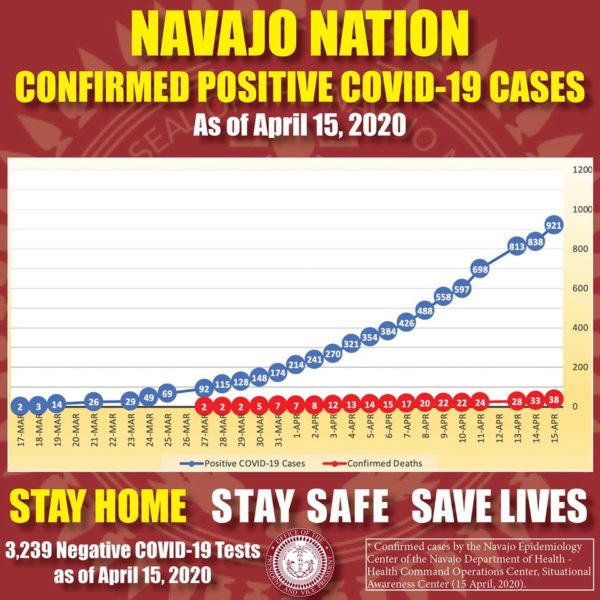
- Details
- By Levi Rickert
WINDOW ROCK, Ariz. — Five more Navajo Nation residents have died of COVID-19, the disease caused by the novel coronavirus as of Wednesday, April 15, Navajo Nation officials say. The death toll now stands at 38.
The total number of positive tests for the deadly disease has reached 921 for the Navajo Nation as of Wednesday – an increase of 83 positive cases since Tuesday according to the Navajo Department of Health and Navajo Area Indian Health Service, in coordination with the Navajo Epidemiology Center.
As of Wednesday, the report also includes 3,239 total negative test results.
The 921 confirmed positive cases include the following counties:
- Navajo County, AZ: 288
- Apache County, AZ: 121
- Coconino County, AZ: 189
- McKinley County, NM: 170
- San Juan County, NM: 119
- Cibola County, NM: 12
- San Juan County, UT: 11
- Socorro County, NM: 7
- Sandoval County, NM: 4
During a live Facebook update on Wednesday, President Nez and Vice President Myron Lizer urged members of the Navajo Nation to be prudent with their stimulus funds and to save as much as possible due to the uncertainties of the ongoing pandemic.
"We truly thank many of those who are abiding by the stay-at-home order and the daily curfew, but it’s very disheartening to receive reports of many people going out into the public today and traveling to border towns – most due to the federal stimulus funds that our people are beginning to receive. We are close to finalizing another public health order to implement 57-hour curfew for the remaining weekends for the month of April,” Navajo Nation President Jonathan Nez said.
For more information including reports, helpful prevention tips, and more resources, please visit the Navajo Department of Health’s COVID-19 website at http://www.ndoh.navajo-nsn.
For up to date information on impact the coronavirus pandemic is having in the United States and around the world go to: https://www.worldometers.info/coronavirus/country/us/?fbclid=IwAR1vxfcHfMBnmTFm6hBICQcdbV5aRnMimeP3hVYHdlxJtFWdKF80VV8iHgE
For up-to-date information about COVID-19, Native News Online encourages you to go to Indian Health Service’s COVID-19 webpage and review CDC’s COVID-19 webpage.
How to help Native News Online: Send us news. Sign up for our daily enewsletter. Follow us on Facebook and Twitter. Share our articles. You can also donate to Native News Online here. Most importantly, take care of yourself. Megwetch.
More Stories Like This
Native News Weekly (August 25, 2024): D.C. BriefsUS Presidents in Their Own Words Concerning American Indians
Star-Studded Livestream to Boost Native News Online’s Year-End Campaign
Monday Morning (December 8, 2025): Articles You May Have Missed This Past Weekend
Native News Weekly (December 7, 2025): D.C. Briefs
Help us defend tribal sovereignty.
At Native News Online, our mission is rooted in telling the stories that strengthen sovereignty and uplift Indigenous voices — not just at year’s end, but every single day.
Because of your generosity last year, we were able to keep our reporters on the ground in tribal communities, at national gatherings and in the halls of Congress — covering the issues that matter most to Indian Country: sovereignty, culture, education, health and economic opportunity.
That support sustained us through a tough year in 2025. Now, as we look to the year ahead, we need your help right now to ensure warrior journalism remains strong — reporting that defends tribal sovereignty, amplifies Native truth, and holds power accountable.
 The stakes couldn't be higher. Your support keeps Native voices heard, Native stories told and Native sovereignty defended.
The stakes couldn't be higher. Your support keeps Native voices heard, Native stories told and Native sovereignty defended.
Stand with Warrior Journalism today.
Levi Rickert (Potawatomi), Editor & Publisher

